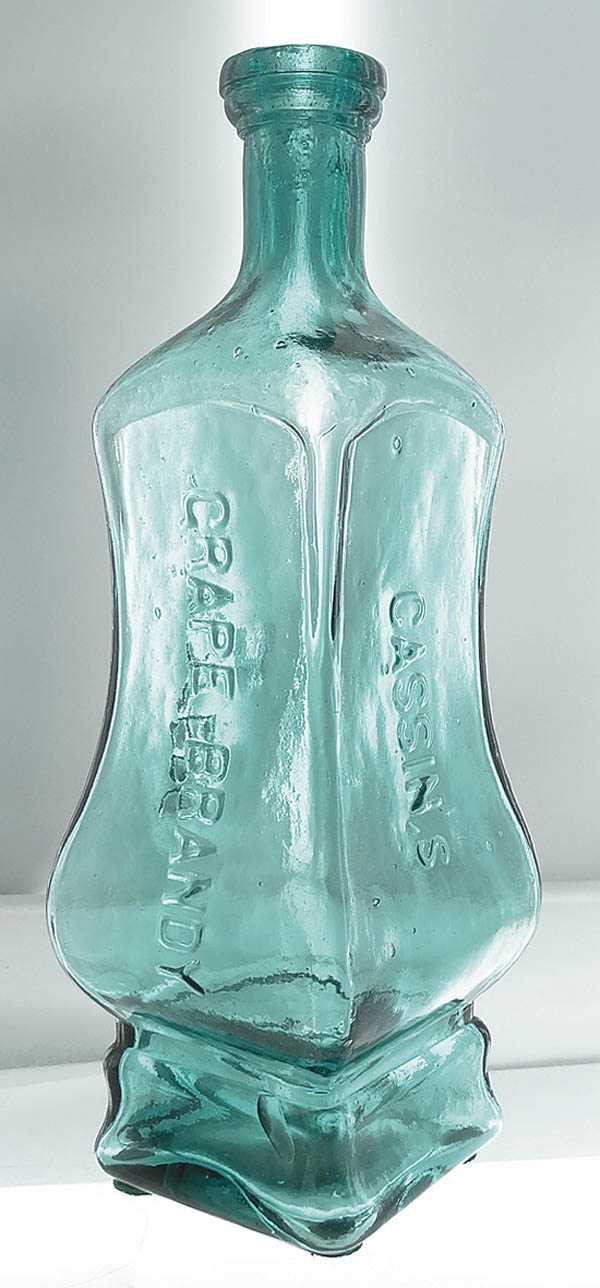Rare Cassin's Grape Brandy Bitters Bottle, Bluish-Teal, Soars To $155,000 In Part One Of Ken Fee Collection Sale
Fine Grouping Of Rare Western Blown Bottles Sold Well
The Cassins Grape Brandy Bitters was the undisputed headliner in American Bottle Auctions Auction #67, part one, an online-only affair with phone and absentee bids also accepted. Part two will be the same. What made the Cassins so desirable to bidders was its bluish-teal color, which many bottle collectors, even seasoned pros, had never seen and were skeptical even existed.
No one had seen Ken Fees collection of over 300 bottles in four decades, said Jeff Wichmann of American Bottle Auctions. It only came to light following his death in 2018. Ive been working with the family ever since. Many of the bottles are outstanding examples that brought a few hundred to many thousands of dollars.
The Cassins Bitters is arguably one of the greatest Western bitters blown. Made in San Francisco, Calif., in 1867 and 1868, its shape was meant to resemble a cello. The first variant of the bottle had thin corners and because of the fragility of the bottle only a few mint examples remain intact today. The second variant eliminated the fragile lines of the bottle, and some still survive today, although there are still believed to be only a half-dozen or so in undamaged condition.
This example, though, was a marvel, regardless of age or history, and the only example known in this unique blue or teal color. In addition, the bottle was in mint condition with no discernable flaws, a rarity for any bottle this old but especially important for the only blue Cassins known to date. It was expected to do well, with an estimate of $75,000-$100,000, but the final price surprised many. All prices quoted include a 10-percent buyers premium.
A Dr. Boerhaaves Stomach Bitters bottle with an applied tapered top, ca. 1868-69, finished at $28,000. This San Francisco-made bitters, with the distinctive windows on the reverse, had its own special identity. This one was a beautiful light to medium green, as these bottles came in a multitude of colors. Graded a high 9 out of 10, the bottle also boasted good whittle and bubbles.
A Henleys OK Bitters bottle with applied band, made ca. 1869-71, graded 9.5 out of 10 for condition, climbed to $21,000. The size of the lettering on the bottle was quite unusual, although it fit very well. The curved R was the most pronounced of any Wichmann has ever seen. With the overall whittle and blue aqua, it will make for quite a bottle on ones shelf, commented Wichmann.
An exceptional Wonsers USA Indian Root Bitters bottle in a bright aqua color, probably blown between 1871 and 1873, changed hands for $25,300. Only a dozen or so aqua examples are known, so they dont come up often, and this one was in mint condition, said Wichmann. When it comes to strike, color, condition and rarity, its hard to top this iconic bottle.
An N. B. Jacobs Rosenbaum Bitters bottle, an early San Francisco bitters blown ca. 1864-68, finished at $904. It would have fetched far more, had it not been for a three-quarter inch hairline crack in the side panel, observed Wichmann. The old amber bottle, variant two, was the smaller size, with the Rosenbaum name embossed on it. It had an unusual top, as these bottles usually had a tapered top with a ring type collar. This example had no taper and, in fact, no ring.
A Lacours Bitters Sarsapariphere bottle, a desirable green with some nice overall crudity, topped out at $14,690. Louis Lacour and his fascination with the lighthouse is evident in this early San Francisco bitters bottle in mint condition. Lacours have become highly sought after in recent years. Prices have escalated in proportion to desirability, according to Wichmann.
A Henleys Wild Grape Root IXL Bitters bottle, an early colored example, ca. 1868-93, went for $3,842. Henley and his partners had great success selling the oddly named IXL bitters product in quart bottles. The production was over a long, but many of those were later variants. Most were aqua, but this one was an unusual green with crudity, and in mint condition, stated Wichmann.
A Catawba Wine Bitters bottle with an embossed cluster of grapes, in pristine condition with a super drippy top, found a new owner for $7,150. It is known that Catawba grapes were grown in Ohio, and it is thought these bottles were made for that market. Some have the graphite pontil, including this one. Collectors love the distinctive embossing and colors they are found.
To learn more, call toll-free at 1-800-806-7722, email info@americanbottle.com, or visit www.americanbottle.com.













